#Solidago spp.
Text
I chose botany because I wanted to learn about why asters and goldenrod looked so beautiful together... Why is the world so beautiful? It could so easily be otherwise: flowers could be ugly to us and still fulfill their own purpose. But they're not... Goldenrods and asters appear very similarly to bee eyes and human eyes. We both think they're beautiful. Their striking contrast when they grow together makes them the most attractive target in the whole meadow, a beacon for bees. Growing together, both receive more pollinator visits than they would if they were growing alone... That September pairing of purple and gold is lived reciprocity; its wisdom is that the beauty of one is illuminated by the radiance of the other... When I am in their presence, their beauty asks me for reciprocity, to be the complementary color, to make something beautiful in response.
- Robin Wall Kimmerer in Braiding Sweetgrass
#q#robin wall kimmerer#braiding sweetgrass#herbarium#botany#herbalism#nature#fall#autumn#September#goldenrod#Solidago spp.#asters#flora#symbiosis#moments of bliss#atmospheric airs#cottagecore#fairycore#ecology
53 notes
·
View notes
Text
Fun Fact: Goldenrod does NOT cause seasonal allergies!
At this time of year, I am suffering from seasonal allergies (ಥ_ಥ). And in honor of these seasonal allergies, I’d like to clear the good name of an innocent plant which has long been blamed for seasonal allergies.
Ahem:
Goldenrod is INNOCENT!!!!!
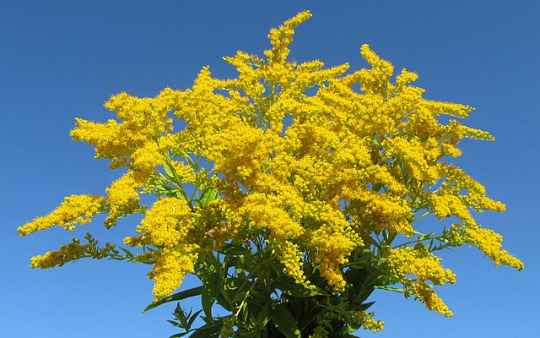
(I love goldenrod (Solidago spp.) and WILL NOT STAND FOR THIS SLANDER)
Now, that isn’t to say that no one is allergic to goldenrod, at all. Some people are, indeed, allergic to this plant, but it is relatively rare and only cause reactions when direct physical contact takes place. These goldenrod allergies do NOT cause the stuffy noses and watery eyes that seasonal allergy sufferers are familiar with (and which I am currently suffering from 😭😭😭😭).
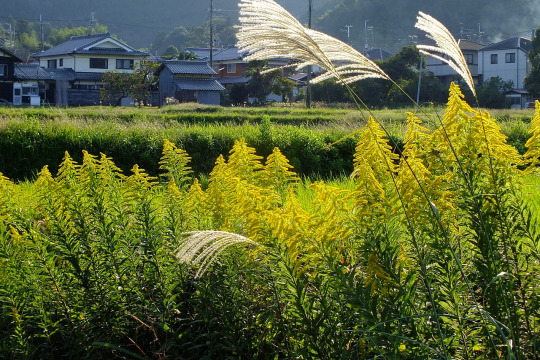
(an innocent bystander 😔)
“But wait!”, you may say, “Every year, without fail, seasonal allergies attack just as the goldenrod begins to bloom!” And this is a fair assumption! There are many times in life where the things we see are causing the things we experience. However, in this case, seasonal allergies and goldenrod flowers are connected by correlation, not causation.
How can I be so sure? Well, because goldenrod pollen is not airborne!

(they’re so good, so pure, so not-currently-attacking-my-airways)
Goldenrod is a plant which is pollinated by animals, primarily insects. Because of this, its pollen is big, heavy, delicious and can’t make it too far from the plant, even with a BIG gust of wind. Instead, an insect covered in goldenrod pollen will fly to a different goldenrod plant, transporting and delivering the pollen in a highly efficient manner, because that is where the plant intends for the pollen to go! Really, goldenrod pollen is unlikely to ever get into your nose (unless you sprinkle it in directly).
Instead, the culprit for your seasonal allergies is MUCH more likely to be an enemy you may have heard of: ragweed.

(*holds up sign that says “Audience Boos”*)
It just so happens that ragweed (Ambrosia spp.) and goldenrod (Solidago spp.) both bloom around the same time, and in the same sorts of environments.
Goldenrod is bright yellow and extremely conspicuous, while ragweed.... well, it doesn’t exactly jump out, visually:
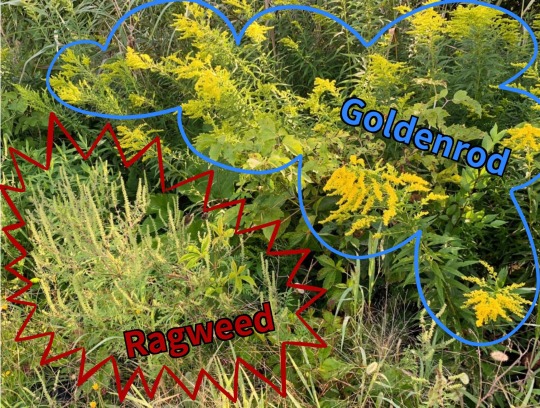
(I circled and labelled them because the ragweed doesn’t exactly… pop out of the picture. ©Janet Allen)
People notice their allergies and then notice the highly conspicuous goldenrod, and they consider the mystery solved. Meanwhile the ragweed remains, hidden in plain sight and the TRUE guilty party.
Ragweed is my eternal enemy the most common cause of seasonal allergies in North America. One reason for that is because ragweed, rather than being pollinated by insects, is instead pollinated via wind, which basically means the plants produce a LOT of very tiny, airborne pollen (about a billion particles per plant), and just hopes that one lands on a different ragweed plant eventually, travelling up to 600 km away. Unfortunately for allergy sufferers, the vast majority of the pollen does not make it to another plant and apparently ends up in my nose instead.
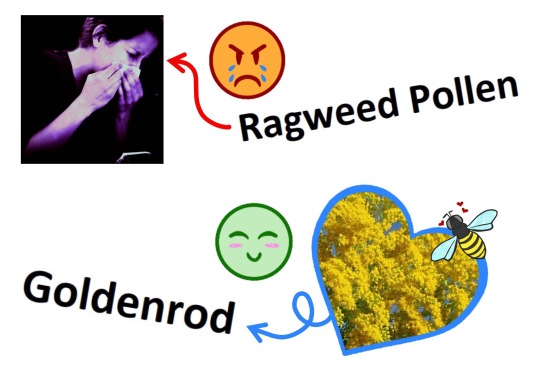
(things that do cause my allergies: ragweed, horses, and mold spores. Things that do NOT cause my allergies: goldenrod.)
Now, I am being a little bit mean to ragweed here, but in my defence, I cannot currently breathe through my nose as a direct result of ragweed, and it has put me in a mean sort of mood (ಠ╭╮ಠ). this is my villain origin story.
That said, I would be remiss not to mention that ragweed is native to North America (although they are VERY invasive in many other places in the world), and so it... I’m sure... that ragweed... it contributes... to the ecosystem... somehow... and we should respect it... instead of assigning... subjective value judgements... to nature (I say, shaking, crying, visibly pained).

(a bumblebee (Bombus sp.) enjoying some goldenrod 🥰)
Goldenrod, on the other hand, is native to North America and is ONE OF MY FAVOURITE THINGS, simply because pollinators LOVE these flowers! I can sit for literal HOURS at a single plant, watching the dozens of different pollinators coming and going. It is also invasive in many other places in the world but THIS ISN’T ABOUT THAT 😭😉😉😉
This has been Fun Fact Friday, where I will defend the honour of goldenrod with my life!
(also: guys there are SO MANY pictures of goldenrod on the internet mislabeled as ragweed, it’s actually blowing my mind. Stock image sites are particularly terrible about this. THE WORLD NEEDS TO KNOW THE TRUTH.)
#biology#plants#allergies#science#ecology#science side of tumblr#sciblr#STEM#fun facts#fun fact friday#adhd in STEM#ragweed#goldenrod
171 notes
·
View notes
Link
#allergies#antispasmodic#bladderinfections#botanicalname#chronickidneydisorders#contraindications#dailylife#Diuretic#flavonoids#garden#gargle#GoldenrodTea#Gout#hayfever#healthcareprofessional#hemorrhoids#immunesystem#incontinence#inflammation#KidneyHealth#kidneytissueregeneration#lowerurinarytractinfections#naturaldiuretic#perennialplant#respiratoryhealth#rheumatism#saponins#skininflammation#Solidagospp.#tannins
0 notes
Text
♓🎏✨ IZBOR DODATAKA PREHRANI ZA DETOKSIFIKACIJU
♓🎏✨ Opis:
Izbor dodataka prehrani za detoksifikaciju relevantan je, osim zbog kemijsko - biokemijskih procesa koji se u ljudskom organizmu odvijaju između aktivnih sastojaka iz hrane te aktivnih sastojaka iz dodataka prehrani, i zbog svoje skupocjenosti.
Dok je kod provedbe zimske detoksifikacije bitan redukcijski udio masti i ulja u ljudskom organizmu i to zbog punobrojno različitih čimbenika, kod provedbe proljetne detoksifikacije, iznimno je bitan optimalan udio istih, a na koji treba obratiti posebnu pozornost.
S tim u vezi, za provedbu proljetne detoksifikacije, preporučuje se primjena onih dodataka prehrani koji u svom kemijskom sastavu posjeduju diuretsko, a samim tim i antihipertenzijsko, djelovanje na ljudski organizam.
Stoga se, primjenjuju Pravilnikom dopuštene vrste spp. Allium, Betula, Hieracium, Orthosyphon, Solidago te Agropyron i Equisetum u kombinaciji s kalijem, magnezijem te askorbinskom kiselinom za regulaciju rada, mišičnog, srčanog te živčanog sustava.
Na prezentacijskoj fotografiji prikazani dodaci prehrani Diurerbe cijene koštanja 13, 20 💶 nemaju sve navedene biljne vrste te su deficitarni na vitaminima B i C, kao i aktivnom sastojku alicinu iz Allium Sativum spp. koji bi, u pravilno raspoređenom udjelu s mineralima Mg - (II) - kation te K+, a za potpuni antihipertenzijski učinak, trebao biti u kombinaciji s navedenim mineralima.
Iz navedenih razloga, a kod proljetne detoksifikacije, Sveučilišna Specijalistica Sigurnosti i Kvalitete Hrane, Magistra Inženjerka Prehrambenog Inženjerstva, Diplomirana Inženjerka Prehrambene Tehnologije i Procesnog Inženjerstva Tijana Dmitrović, Sveučilišno Osposobljena Za Neklinički Razvoj Lijekova i Sigurnost u Farmakologiji upućuje na primjenu škrobnog voća i povrća u kombinaciji s koštunićavim voćem, a kako je navedeno gastro - kulinarskim prezentacijskim naputkom Proljetna Salata Od Krumpira!
https://m.facebook.com/story.php?story_fbid=166282876356247&id=100089236054064


0 notes
Text
♓🎏✨ IZBOR DODATAKA PREHRANI ZA DETOKSIFIKACIJU
♓🎏✨ Opis:
Izbor dodataka prehrani za detoksifikaciju relevantan je, osim zbog kemijsko - biokemijskih procesa koji se u ljudskom organizmu odvijaju između aktivnih sastojaka iz hrane te aktivnih sastojaka iz dodataka prehrani, i zbog svoje skupocjenosti.
Dok je kod provedbe zimske detoksifikacije bitan redukcijski udio masti i ulja u ljudskom organizmu i to zbog punobrojno različitih čimbenika, kod provedbe proljetne detoksifikacije, iznimno je bitan optimalan udio istih, a na koji treba obratiti posebnu pozornost.
S tim u vezi, za provedbu proljetne detoksifikacije, preporučuje se primjena onih dodataka prehrani koji u svom kemijskom sastavu posjeduju diuretsko, a samim tim i antihipertenzijsko, djelovanje na ljudski organizam.
Stoga se, primjenjuju Pravilnikom dopuštene vrste spp. Allium, Betula, Hieracium, Orthosyphon, Solidago te Agropyron i Equisetum u kombinaciji s kalijem, magnezijem te askorbinskom kiselinom za regulaciju rada, mišičnog, srčanog te živčanog sustava.
Na prezentacijskoj fotografiji prikazani dodaci prehrani Diurerbe cijene koštanja 13, 20 💶 nemaju sve navedene biljne vrste te su deficitarni na vitaminima B i C, kao i aktivnom sastojku alicinu iz Allium Sativum spp. koji bi, u pravilno raspoređenom udjelu s mineralima Mg - (II) - kation te K+, a za potpuni antihipertenzijski učinak, trebao biti u kombinaciji s navedenim mineralima.
Iz navedenih razloga, a kod proljetne detoksifikacije, Sveučilišna Specijalistica Sigurnosti i Kvalitete Hrane, Magistra Inženjerka Prehrambenog Inženjerstva, Diplomirana Inženjerka Prehrambene Tehnologije i Procesnog Inženjerstva Tijana Dmitrović, Sveučilišno Osposobljena Za Neklinički Razvoj Lijekova i Sigurnost u Farmakologiji upućuje na primjenu škrobnog voća i povrća u kombinaciji s koštunićavim voćem, a kako je navedeno gastro - kulinarskim prezentacijskim naputkom Proljetna Salata Od Krumpira!
https://m.facebook.com/story.php?story_fbid=166282876356247&id=100089236054064


0 notes
Text
♓🎏✨ IZBOR DODATAKA PREHRANI ZA DETOKSIFIKACIJU
♓🎏✨ Opis:
Izbor dodataka prehrani za detoksifikaciju relevantan je, osim zbog kemijsko - biokemijskih procesa koji se u ljudskom organizmu odvijaju između aktivnih sastojaka iz hrane te aktivnih sastojaka iz dodataka prehrani, i zbog svoje skupocjenosti.
Dok je kod provedbe zimske detoksifikacije bitan redukcijski udio masti i ulja u ljudskom organizmu i to zbog punobrojno različitih čimbenika, kod provedbe proljetne detoksifikacije, iznimno je bitan optimalan udio istih, a na koji treba obratiti posebnu pozornost.
S tim u vezi, za provedbu proljetne detoksifikacije, preporučuje se primjena onih dodataka prehrani koji u svom kemijskom sastavu posjeduju diuretsko, a samim tim i antihipertenzijsko, djelovanje na ljudski organizam.
Stoga se, primjenjuju Pravilnikom dopuštene vrste spp. Allium, Betula, Hieracium, Orthosyphon, Solidago te Agropyron i Equisetum u kombinaciji s kalijem, magnezijem te askorbinskom kiselinom za regulaciju rada, mišičnog, srčanog te živčanog sustava.
Na prezentacijskoj fotografiji prikazani dodaci prehrani Diurerbe cijene koštanja 13, 20 💶 nemaju sve navedene biljne vrste te su deficitarni na vitaminima B i C, kao i aktivnom sastojku alicinu iz Allium Sativum spp. koji bi, u pravilno raspoređenom udjelu s mineralima Mg - (II) - kation te K+, a za potpuni antihipertenzijski učinak, trebao biti u kombinaciji s navedenim mineralima.
Iz navedenih razloga, a kod proljetne detoksifikacije, Sveučilišna Specijalistica Sigurnosti i Kvalitete Hrane, Magistra Inženjerka Prehrambenog Inženjerstva, Diplomirana Inženjerka Prehrambene Tehnologije i Procesnog Inženjerstva Tijana Dmitrović, Sveučilišno Osposobljena Za Neklinički Razvoj Lijekova i Sigurnost u Farmakologiji upućuje na primjenu škrobnog voća i povrća u kombinaciji s koštunićavim voćem, a kako je navedeno gastro - kulinarskim prezentacijskim naputkom Proljetna Salata Od Krumpira!
https://m.facebook.com/story.php?story_fbid=166282876356247&id=100089236054064


0 notes
Text
The Plant Allies of Spring: How to Create a Spring Wellness Apothecary

By Alexis J. Cunningfolk
Forever ago I wrote a blog post on creating your own herbal apothecary for the winter months, but it's not just winter that I'm adjusting what's on my apothecary shelves. Every season brings new needs and new herbs growing on the Land, so I thought it would be useful to write about creating home apothecaries for wellness for each of the seasons.
As with my winter wellness suggestions, I've organized my recommendations into general herbal actions that I find useful in the springtime such as anti-inflammatory herbs for allergies. I've tried to highlight herbs that are easy to access (especially in North America, where I am writing this from) and/or inexpensive to grow yourself, but hopefully you'll feel inspired and able to work with herbs local to your area.
So with that in mind let's explore some of the common ailments and remedies for the season of spring!

Finding Balance: Managing Seasonal Allergies
Herbal Actions: Anti-inflammatory, antihistamine, anti-catarrhal, and respiratory tonics
Here's my caveat about herbs and allergies: I do think that many folks benefit from working one-on-one with a local herbalist to help figure out your allergies and reactivity because a) allergies can be tricky to figure out and the individualized care a practitioner can offer can be essential, b) there are often layers of reactivity occurring (including food allergies and neuroplastic reactivity) that need exploring and c) a local herbalist can help you work with local herbs which is often very beneficial to alleviating allergies.
All that said, there are a lot of herbs that are generally useful for allergies and helping the body be less reactive and inflammatory during allergen abundant times like spring. The following herbs are protective against seasonal allergies, energize body systems, and generally help the body move from winter to spring.
Nettles (Urtica dioica): A nutritionally dense plant ally, Nettles is a great herb to work with in strengthening and nourishing our body. It has antihistamine qualities and helps to "build the blood" which speaks to both its iron content, but the herbs overall nutritive and energizing (but not stimulating) healing qualities.
Goldenrod (Solidago spp.): A beloved ally for helping to alleviate seasonal allergies, Goldenrod is adept at relieving congestion and sinus pain.
Lemon Balm (Melissa officinalis): A good tonic herb, known for bringing joy and life to those who ingest it. Lemon Balm helps to protect against overwhelm, whether that's feeling overwhelmed by change, social situations, spring allergies or whatever else is looming large in your life.
Peppermint (Mentha piperita): If you're feeling particularly sluggish this spring, turn to Peppermint to help sweep away the remaining drowsiness of winter so you can connect with the energy of the new season. The anti-inflammatory qualities of Peppermint help us to breathe deeper, reduce the brain fog that often come along with allergies, and infuse us with some hope that this too shall pass.
Dandelion (Taraxacum officinale): The arrival of Dandelion on the Land I live with is a time of celebration. There will be medicine that can be made again for the year ahead and enjoying Dandelion medicine during the early days of spring is like filling up the body with spring energy from the inside out. Dandelion helps to reduce sinus inflammation and expel excess mucus (along with the allergens it carries).
The Internal Fire: Nourishing Digestion
Herbal Actions: Bitters, cholagogues, anti-spasmodic, anti-inflammatory, carminatives, and nervines
One of the most important ways of supporting health from a traditional western herbalism perspective, is supporting the digestive fire (or metabolic processes) of the body. After the slowness of winter and the long stretch of cold, in the spring we want to support the building up of digestive effectiveness as we become more active and the days heat up. Finding the right digestive herbs for your constitution can take a bit of effort (which is why working with an herbalist one-on-one can be so valuable - you deserve such support), but when you find your digestive plant allies, it can be life changing.
Dandelion (Taraxacum officinale): The roots are a good overall spring tonic, helping to wake up our winter bodies to the season of spring. I like to drink a decoction of the roots during early spring (sometimes with a recipe like this) and enjoy making and taking my own whole plant Dandelion tinctures (i.e. the roots, leaves, flowers of Dandelion) to enjoy throughout the year.
Chamomile (Matricaria chamomilla): Another good overall spring to summer tonic and digestive aid, I especially like recommending Chamomile for highly sensitive people who tend to get upset stomachs when experiencing disruption to their day and routine (including struggling with the change of season). Chamomile is also a plant ally for folks who tend to have an overactive or fast digestion (may be indicated via signs of cramping, diarrhea, and gas).
Calendula (Calendula officinalis): Deeply reparative to the digestive system and often a good ally for folks who suffer from bloating, fatigue, and gas after meals.
Rose (Rosa spp.): A helpful ally when it comes to supporting the microbiome of our gut, acting as a prebiotic as well as supporting digestion through the promoting the production of bile.
Other digestive spring aids include Lemon Balm (Melissa officinalis), Peppermint (Mentha piperita), Ginger (Zingiber officinalis), Rosemary (Rosmarinus officinalis), and Sage (Salvia officinalis).

Waking Up From Winter: Brain Fog & Brain Tonics
Herbal Actions: Nootropics, nervines, and adaptogens along with herbs for digestive health to support the brain-gut axis.
The winter season has hopefully brought some much needed slowness and rest to your life. Just like getting up in the morning after a long night's sleep, waking up from the winter months can take a bit of time. I like to reach for herbs that support brain health and mental clarity, helping to sweep away the cobwebs of winter so that I can best enjoy the energy of spring.
Lemon Balm (Melissa officinalis): My favorite ally for alleviating brain fog and helping to promote mental clarity. It's also a plant ally known to bring joy and support our ability to feel part of the world and not be overrun by it - something which can feel especially useful between the slowness of winter and the speediness of spring.
Sage (Salvia officinalis): A classic brain tonic, Sage is known as an herb of wisdom, promoting mental clarity and discernment.
Milky Oat (Avena sativa): A great ally for those feeling exhausted and not ready to be doing much of anything, much less transitioning into a new season. A supremely generous tonic for the nervous system as well as supporting our mental health.
Other brain tonics include Gotu Kola (Centella asiatica), Gingko (Gingko biloba), and Ashwagandha (Withania somnifera).
Two Steps Forward, One Step Back: Springtime Colds & Fevers
Check out my winter apothecary post for recommendations on herbs for different types of colds, coughs, and fevers.
Breathing Deeply: Respiratory & Lung Health
Herbal Actions: Anti-inflammatories, demulcents, astringents, aromatic, and expectorants.
Honoring the breath is an important part of my personal and professional practice. I've written about breathwork and the herbs that support breathwork practices, all of which can be incorporated into a spring apothecary.
Yerba Santa (Eriodictyon californicum): If you have the sort of spring allergies which cause a lot of damp and mucus, drying Yerba Santa might be a good ally for you. It's a respiratory tonic and nervine helping us to connect deeply to our breath and nervous system.
Mullein (Verbascum thapsus): If you've had a long season of being sick this past winter, Mullein can be a great ally, especially if there is a lingering cough. I like combining Mullein with Elder (Sambucus nigra) and Peppermint (Mentha piperita) for a lung-opening, immunomodulating blend. A helpful ally for those whose asthma is irritated by the increase in heat and allergens that spring brings.
Elecampane (Inula helenium): A good herb for seasonal allergies and stubborn coughs of all sorts.

The Body In Motion: Supporting the Lymph Nodes
Herbal Actions: Lymphatic, alterative, anti-inflammatory, and astringent
Some of the first herbs to spring up after winter are ones that support lymphatic health, helping to drain congested lymphs and reduce overall inflammation. Often considered weeds by the general public, these herbs deserve respect and can be a beautiful and inexpensive way to access herbal medicine. Be sure to leave enough herbs to go to seed and continue to spread out across the Land to where they are most needed.
Cleavers (Galium aparine): These sweet and sticky herbs help to support the activity of white blood cells clearing out congestion in our lymph nodes. These are best taken fresh either as a tea or blended into smoothies.
Calendula (Calendula officinalis): If you're in a state of lymphatic congestion, Calendula can be a beautiful ally to work with. The bright flowers shine through our system, chasing out shadows of sluggishness, helping to promote lymphatic drainage and circulation.
Dandelion (Taraxacum offcinalis): Dandelion helps to repair and support the filtering systems of our body including our liver, kidneys, digestive tract, and lymph nodes. The herb helps to promote the production of lymphocytes which makes it a wonderful lymph tonic to work with throughout late winter and early spring.
Other lymph tonic herbs include Chickweed (Stellaria media), Echinacea (Echinacea purpurea), and Ocotillo (Fouquieria splendens).
🌿
There you have it friends - herbal allies for the spring season! I hope you're feeling inspired to build your own home apothecary using a few easily accessible herbs to support your health and the health of those you serve. In my own life, spring is a time of trying to use up last year's stock of herbal remedies so that I can make space for new ones, long and lovely hours in the garden, checking in with the energy of the season, and working all sorts of springtime magick.
You can also learn about the seasons from an astrological perspective, starting with Aries. If you’re in the southern hemisphere the start of spring is marked by Libra (post coming soon!).
I hope that you find the rhythm of seasonal change that works the best for you and your loved ones, so that you can thrive in times of change and feel nourished by the possibility of what is coming into being.
http://www.wortsandcunning.com/blog/tag/wellness+apothecary+series
0 notes
Text
Lucky Maggot Ball Charms!
Lucky Maggot Ball Charms!
This is goldenrod (Solidago spp.), an edible native plant that is often unjustly dismissed as a mere weed. Medicinally, it’s been used for a wide variety of things, including the treatment of skin infections, colds, and gall bladder problems. Depending on how it’s prepared, it can also be an emetic or a sedative.
Spiritually, it’s useful for breaking love spells and clearing up crossed…

View On WordPress
0 notes
Text



9/5/21
0 notes
Photo

Fall prairie scene- post burn the previous year.
Every year that they burn, the floral diversity increases and so does the imbrication, but why, how does this allow recruitment?.
Here is an old field successional sight with some common fall blooming forbes at Glenwood Gardens. This year meant more successful imbrication of forbes post fire year. This kind of disturbance, low burning fires or RX fires(in this case), are capable of allowing more seeds to find the soil(including new species), clear duff, increase nutrient dynamic, clear weeds(like woodies and invasives), and open up spaces for light-seed contact. The re-invigoration process of burns is critical for prairie structure and restoration.
At my home, I try to do one section of my yard as a fall or winter burn, and one section of my yard as a spring burn, or leave it for next burn season and alternate. This is very important, as with smaller spaces and pocket prairies, their lacks a continuum of habitat, prairie shrub thicket islands, and natural burn brakes that would cause conditions of burn sectioning(spots left unburned that year); because, I too lack this natural habitat, I can’t rightfully burn it all at once, ecologically leaving these spots unburned means habitat for native overwintering insects that require leaf litter and stems to complete their phenological cycles.
On a side note,
This Old field successional site isn’t to diverse compared to the remnant and re-seeded areas near by, It was left to become seeded over time by natural seed dispersal. Because of that, we see very few species that aren’t ruderal in this place. Deer dispersed members of fabaceae, asteraceae, and lamianaceae, Bird dispersed rosaceae and ranunculaceae, and apiaceae with few bird dispersed members of asteraceae, Most are wind dispersed asters: Solidago spp.(mainly tall goldenrod), giant ironweed, 4 common asters make up the majority of the plants found in this section. We see two wind dispersed native grasses ( little blue stem and broom sedge (a grass not a sedge called Andropogon virginicus)) and one grass that managed to find its way here from deer that were bedding in it (indian grass).
[This shows that human intervention (seed mix broadcasting) can be useful for speeding up species diversity in areas with low connectivity].
The photo above is mainly Symphyotrichum novae-angliae( native), Daucus carota(non native), Symphyotrichum pilosum (native), Solidago altissima( native)
70 notes
·
View notes
Text


Blazingstar or gayfeather Liatris punctata, sunflower family Asteraceae.
This, alongside tick trefoil Desmodium spp. (Fabaceae), is a welcome splash of purple outside town. L. punctata and its relatives the goldenrods Solidago spp. are absolutely flaming right now, presumably throughout their range from Mexico right up to Canada.
Saw lots of wasps on these, but no bees despite being a stone’s throw from a cultivated hive and surrounded by wild ones. A small sample, but still; the honeybees seemed way more interested in the goldenrod.
12 notes
·
View notes
Text

Goldenrod Cornbread
Here we have a plant that fills you with the light of summer sunshine. It nourishes and heals your body and helps you find your way back to faith and hope and joy when your strength is waning and your body heavy. And in late summer, that melancholy heaviness can set in all-too-easily with the stagnancy of slow-moving air and the smoke that fills the West during the peak of forest fire season. It’s time to consume the bounty of summery golds and move slowly but with purpose to prepare ourselves for the onset of Autumn.
#p#food centric herbalism#good eats#herbarium#goldenrod#Solidago spp.#herbalism#gastronomy#recipes#fall#autumn
23 notes
·
View notes
Text

The month since the last bloom day, that is, from 16 Aug. to 15 Sept., has definitely brought a shift from high summer to nascent fall. Temperatures ranged from highs of 88F to 66F (average of 77 over 31 days), and lows from 42-65F (average of 52.6 over 31 days). This last week we’ve experienced a high of 86F one day, four days that hit the low 70s, and two days that reached only the high 60s. I can see low temperatures in the 30s coming up in the 10-day forecast. Most significantly, I switched from skorts to pants about a week ago, and we had our first woodstove fire of the season last night.
*
Peach time came and went, a short season from about 20 Aug. until 7 Sept., during which time we picked about 600 peaches that were “keepers,” fewer than last year but most of these were bigger and less blemished. The best ones we ate for breakfast, lunch, dinner, and snacks, and gave away to friends and neighbours; those that had some damage (but were mostly fine) became peach pie (2 pies), peach cobbler bread (12 loaves), and dried peach slices. And now the peach trees are bare again.
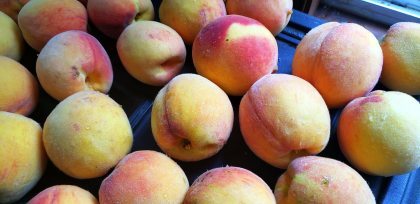
*
The blooms that shine in my early September garden include:
EUTROCHIUM purpureum (Joe Pye weed), still going strong and attracting the lion’s share of the butterflies.
*
a variety of SEDUMS (stonecrop), including Autumn Fire, Autumn Joy, Hab Grey, and Turkish Delight
*
GOLDENROD (Solidago spp; volunteers all), shown with holly, phlox, hydrangea
*
KIRENGESHOMA palmata (yellow waxbells). Frankly, one plant is not a show stopper; you wouldn’t notice mine if you weren’t looking for it. But it’s one of my favourite perennials, even though it’s yellow, because of its unusual leaves and flowers.



*
HELENIUM autumnale (sneezeweed), reblooming from a Botanical Interests’ “Bring Home the Butterflies” seed mix of several years ago


*
PHLOX
*
GENTIANA asclepiadea (willow gentian)
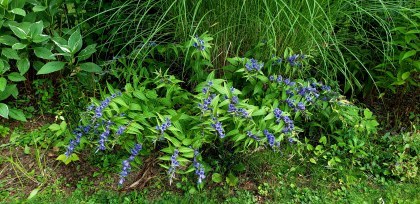
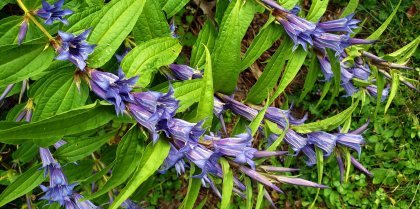


*
CLETHRA alnifolia ‘Ruby Spice’ (summersweet)
*
HYDRANGEAS (mostly PeeGee)





*
BUDDLEIA davidii ‘Ellen’s Blue’ (butterfly bush)
*
CHELONE lyonii ‘Hot Lips’ (turtlehead). I love watching bumblebees push their way inside the blooms and emerge covered in pollen.
*
wild ASTERS
*
BONUS: A few more flowers I’m fond of right now:
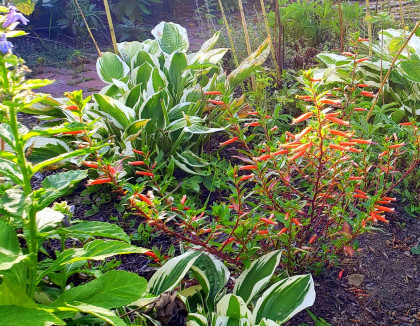
Vermillionaire – large firecracker plant (a cuphea hybrid) , an annual, with some ‘Patriot’ hostas

Anemone tormentosa ‘Robustissima’

Anemone tormentosa ‘Robustissima’ buds

Anise hyssop (Agastache foeniculum)
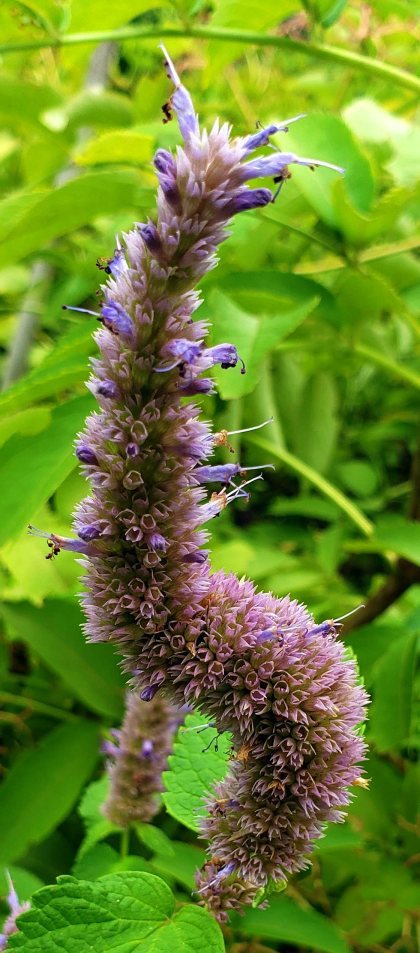
a playfully shaped anise hyssop (Agastache foeniculum)

Perovskia atriplicifolia (Russian sage)

volunteer Lobelia siphilitica (great blue lobelia)
*
I’m not sure what I’ll have to show for October other than a pink aster (can’t recall name) and Aster laevis ‘Bluebird.’
And then there will be only autumn leaves (fall’s true flowers), and after that … snowcover until April.
*
Spent by Mark Doty
“Late August morning I go out to cut
spent and faded hydrangeas—washed
greens, russets, troubled little auras
of sky as if these were the very silks
of Versailles, mottled by rain and ruin
then half-restored, after all this time…
…
In their silvered jug,
these bruise-blessed flowers”
(The whole poem is worth reading, here)
*
Garden Bloggers’ Bloom Day is hosted by Carol at May Dreams Gardens.
September Bloom Day The month since the last bloom day, that is, from 16 Aug. to 15 Sept., has definitely brought a shift from high summer to nascent fall.
#anise hyssop#blooms#buddleia#chelone#clethra#flowers#Garden Bloggers’ Bloom Day#GBBD#gentian#goldenrod#hydrangea#Joe Pye Weed#kirengeshoma#Mark Doty#phlox#sedum#September#summer
3 notes
·
View notes
Text
Backyard wildflowers 1/?
(A series of posts on wildflowers and volunteers in my backyard. I wanna share my flower and plant pics. My parents have been letting the garden go more this past year so I have lots of pics of the "weeds". I fought off so many mosquitos to take these.)
One of my favorite times of the year is now, when summer is on its way out and fall is scooching in. I love the weather and I love GOLDENROD!
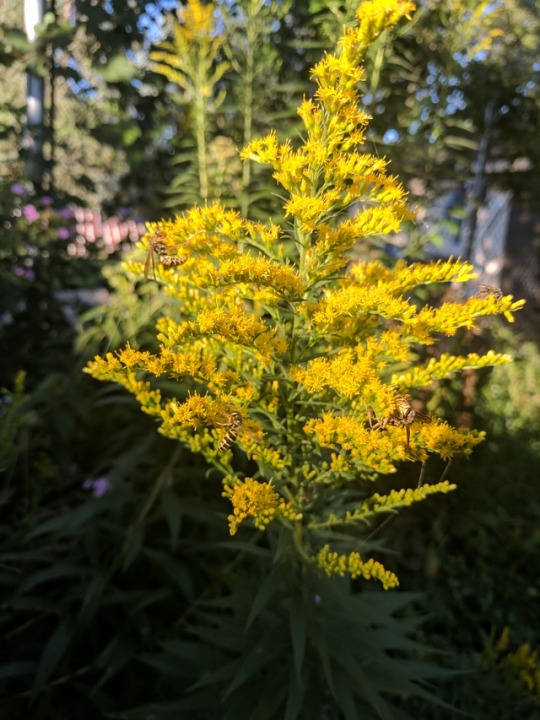
A member of the aster family, goldenrod is a huge variety of plants spanning over 100 species, most native to North America. They can be seen brightening fields, roadsides, and open woods in late summer to the first frost, depending on species and hardiness zone. Most species don't like to be disturbed much, so anywhere off the side is Free Realestate™️. They're often seen as a weed and blamed for seasonal allergies, but they are insect-pollinated as seen above, not air-pollinated - their pollen doesn't cause congestion or itchy eyes (unless you shove your face directly into the flowers). If you're interested in insects, watching over some goldenrod is sure to give you a nice variety of native pollinators to admire. You can literally watch pollen sacs fill up in bright yellow. Our patches often host bumblebees and other small native bees. Butterflies, too.
That being said, goldenrod doesn't play nice with others. It's an aggressive perrenial and spreads quickly and efficiently, using both aerial seeds and rhizomes to take over flowerbeds. It can be considered an invasive species if introduced to another ecosystem. Some species are less aggressive, but they're less likely to be the volunteers springing up on your property or by the railroads. Ime, it does better with other aggressive native plants. The phlox and black-eyed susans in our yard balance them fairly well. If you don't want them in yours, pull em up sooner rather than later. They're harder to uproot the older they get.
Scientific name: Solidago spp.
Common names: Aaron's rod, woundwort, goldruthe, goldenrod
Height: 2 - 6.5 feet (depending on species)
Uses: can be used to make pretty yellow dye, as well as herbal tea. The leaves of all species of goldenrod are edible, and can be used medicinally (WITH CAUTION). They are diuretic, anti-inflammatory, and can be found in a pill form (more reliable dosage and guaranteed food grade, so no worries about pesticides or roadside pollution) as an herbal supplement. Doctors are still studying it, and there is "insufficient data on its effectiveness". Please remember that even if a plant is "all natural", that doesn't mean it won't have side effects or that it won't negatively interact with other meds or herbal treatments. Even stuff like Tylenol. Consult a doctor or licensed herbalist who knows your medical history. I've never eaten ours cuz I already pee a lot (they're diuretic, remember), our leaves often have an unknown fungus on them, and I live in Chicago so contamination with neighbors' pesticides and stuff is possible.
Personal Associations: (YMMV) drawing things to you, liminality, joy, confidence, warmth, mutual support, abundance, meeting goals through more than one way/path, wishes (native alternative to dandelion seeds), determination/perseverance, if you want a spell to lodge its roots deep and grab hold hard and fast it's a good plant to recruit. This may make it harder to undo, tho. Goldenrod's worked with magic users and herbalists for a long time, so it tends to be easier to approach and work with.
Warning: MAKE SURE a plant is truly edible and you aren't allergic to it before harvesting. Goldenrod has DEADLY look-alikes. (I may do a post on em, tho I haven't found any near my house). DONT DIE. Harvest Responsibly, most golden rod are native species. Google how to do that.
Now that that's done:
Look at these fuckers

These babes grow over 6ft tall. Called Solidago gigantea for a fuckin reason. (Ft. Some black eyed susans and a little pink phlox hiding back there). They prefer full sun

Look how tiny those compound flowers are.


Serrated 3-veined alternating leaves, no branching stem, leaves tend to get slightly bigger further down the stem, no leaves at the base. Diameter of stem is almost an inch. Somewhat woody. Deep roots.

The height on this dude is close to 5ft, but the way the flowers cluster and arc on it seems different from the S. gigantea species. Not sure, but possibly S. canadensis? Goldenrods make hybrids easily due to the large variety, so taxonomy is difficult. Local field guides can help. Couldn't get a closer look cuz the wild blackberry was stAbBIng mE.

No idea what these pointy pyramid/mountain kids are either. Bugs like em tho. Its not a fluke, there's multiple of them in the more shady area of the yard. Seems to be comfy in partial shade. No leaf serration, single vein, alternating growth with leaf rosettes, couldn't see the base. I wanna say 4-5 ft tall?
#plants#goldenrod#solidago#backyard wildflowers#mine#what do you mean#i cant do read mores on tumblr mobile???#long post#sorry#what do you mean no one asked for this
2 notes
·
View notes
Text
Forbes
Forbs are herbaceous plants that flower, and are not a grass. They tend to give gardens and meadows their ”pop” and have many ecological benefits as well. Forbs provide nectar for pollinators, forage and habitat for wildlife and can be great for soil stabilization. Here are some favorite forb species to include in your garden: Goldenrod (Solidago spp.)Asters (Symphyotrichum spp.) Sunflowers…

View On WordPress
0 notes